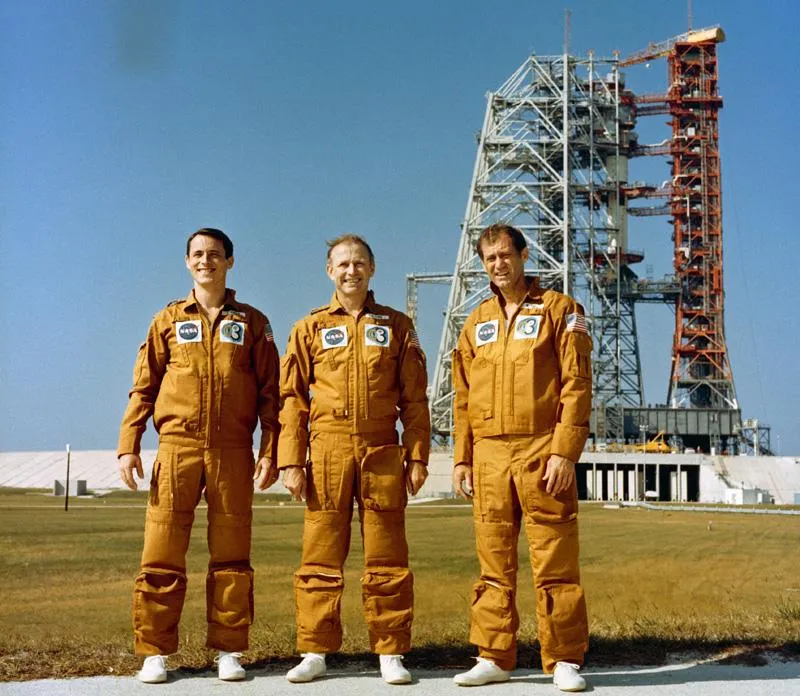Making Skylab Human-Friendly
Best known for his iconic designs, from the Lucky Strike logo to Air Force One, Raymond Loewy also consulted on NASA’s first space station.
/https://tf-cmsv2-smithsonianmag-media.s3.amazonaws.com/filer/3d/e6/3de62d38-0820-4f73-a3e8-71e39150bc7b/skylab.jpg)
They dined on Lobster Newberg, fresh bread, and butter cookies, and slumbered in their own individual berths, which had the luxury of privacy curtains. But in the blackness of space, there was one thing the Skylab astronauts still craved: Color. As Skylab commander Gerald Carr told the New York Times in September 1994, the astronauts were so starved for color they would stare at the test color bars used to calibrate their cameras.
Skylab was the United States’ first temporary space station (it was occupied between May 1973 and February 1974), and effort was put into making it habitable. NASA hired the industrial design firm Raymond Loewy/William Snaith, which had already worked with the U.S. Navy, Coast Guard, and the Maritime Commission. The firm was hired to evaluate Skylab’s “floor plan arrangement, color schemes, lighting, noise levels, and all other factors relating to human comfort in confined quarters,” writes historian Layne Karafantis in a 2013 paper.
Loewy’s iconic designs permeated 20th-century America: the interlocking Exxon logo; the simple shell of Shell Oil Company; the clean, uncluttered packaging of Lucky Strike cigarettes. The streamlined locomotives for Pennsylvania Railroads; the appealing curves of the 1953 Studebaker Starliner; the futuristic Studebaker Avanti: all were Loewy classics. (Click here to see an astonishing number of designs created by Lowey.)
Born in Paris in 1893, Loewy was first captivated by flight as a teenager, when he saw Alberto Santos-Dumont flying his Demoiselle over the Bois de Boulogne. He would go on to design the office of Stuart Symington in 1947 when Symington was named secretary of the Air Force, and would create the interiors of the Boeing 307 Stratoliner and the Lockheed Constellation. John Wall writes in Streamliner that Loewy even came up with a concept during World War II for “a glider…that could come in for a landing and immediately be converted into a field hospital.” He would create the iconic livery of Air Force One at the request of First Lady Jacqueline Kennedy.
Loewy was 75 years old when he accepted the Skylab commission, but he threw himself into the project, writes Wall, “taking part in astronaut tests, donning spacesuits, and learning astronaut lingo, which Loewy dubbed ‘orbit talk.’ ” While Huntsville engineers didn’t see the value of Loewy’s suggestions, according to Karafantis, NASA spaceflight director George Mueller felt that astronauts deserved more than “a boiler room” in which to live. While Loewy’s designs emphasized efficiency, they also stressed psychological comfort. He objected to an excess of blue colors in the multiple docking adapter, writes Karafantis, as it might “accentuate the pallor of the crew’s complexions during the latter stages of occupancy,” and suggested the placement of overhead lights be reconsidered, as he feared they would cast “eerie shadow patterns.” He promoted bright colors as a way to prevent visual boredom, an inflight library, and children’s drawings. He also argued for a two-piece work uniform (below), which the astronauts initially resisted.

Perhaps Loewy’s most important contribution to Skylab was his insistence upon adding windows; Skylab was eventually equipped with six, a feature the astronauts rated “spectacular.” Loewy would go on to serve as the habitability consultant for the Space Shuttle and the Space Station; he died in 1986, at age 92, in Monte Carlo.